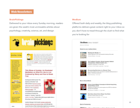
How to Build a Master Content Calendar That Covers All Your Bases
Feb 28th, 2023 by Nikola Sekulic
No matter how brilliant your content ideas might be, you need a way to disseminate your content across different channels effectively, in various interactive formats, and you need to do so consistently.
Regular, well-tracked, and analyzed content, combined with consistent audience engagement, is what will elevate your mediocre content strategy to an exceptional one. For that to happen, you need a strategic, well-established content calendar that is perfectly aligned with your brand strategy.
While Issuu helps generate interactive creative assets efficiently, making it much easier for you to distribute a range of on-brand content across channels, your publishing cadence also needs to be stellar. Let’s dive into what a content calendar is and how you can build one to support your content strategy.
What is a content calendar and why is it important?
Your content calendar is so much more than a publishing schedule. It should be a collaborative, creative outline of your editorial “when” and “where”, showing exactly what kind of content will be published, by whom (if it’s not done automatically), in what format, and on what platform.
It should be easy to align your calendar with your content strategy as well as your other departments. After all, if your content serves to support your marketing, sales, and overall engagement goals, the calendar should be adapted to reflect those objectives.
That is why businesses, especially those with complex content strategies, need to use a trustworthy content calendar platform that enables cross-team collaboration, promotes consistent publishing, and provides the ability to track different KPIs.
For example, here’s how Buffer, the well-known social media scheduling platform, leverages Trello to build out their own calendar:

Note that in addition to actual content pieces, their calendar is also collaborative, instructional for the team, and extremely user-friendly, which further enables fast-paced content management across various departments.
Leveraging a calendar also means you won’t find yourself accidentally posting the same, repetitive formats all the time; you can easily use content transformation and digital publishing platforms like Issuu to adapt your content to provide variety and consistency in one fell swoop. Turn a single document into a range of dynamic assets for promoting on every channel, like digital flipbooks, mobile-optimized articles, eye-catching social posts, email GIFs, and more – making your content go further than ever before, with less work required.
Set clear goals and put them in a concrete timeframe.
Defining the goals of your content strategy and content calendar is the first step toward creating a calendar that works for your business. Marketing experts can then use these overarching goals to work their way back through the tactics and processes necessary to build a content calendar with clear KPIs and OKRs.
For example, a strong SEO strategy relies heavily on creating informative, value-driven pieces that allow you to increase organic traffic, improve social media engagement, and generate qualified leads.
It’s also important to note that different goals will have varying timeframes (some being short-term, others long-term), and require posting content across multiple channels in diverse formats that can be easily accessed on every device. Keep an eye on emerging content trends to excel in creating, publishing, and distributing top-performing formats, and make the most out of your calendar by posting at optimal times.
Choose the best way to disseminate content.
Content dissemination is a crucial part of any well-rounded content calendar, which needs to include various relevant channels.
For instance, once you publish an article, you can spread the word via email to ensure more visibility and engagement with your new piece. To avoid landing in spam and to boost genuine interest, create engaging email subject lines that are worthy of the article inside.
Are you working with influencers? If so, schedule your influencer outreach in your calendar to make sure they, too, will help re-share your latest article, eBook, and anything else you publish.
If you’re on social media, your calendar is a great way to keep your followers informed of new content waiting for them on your website and make it easy for them to access it with a single click through a social post.
Create content that's current and relevant.
No calendar can be useful if the content you’re looking to publish isn’t up to par. That’s why it’s important that we talk about the quality of the content and why quality content is important for SEO, engagement, brand authority, lead generation, and for achieving any other business goal. Be mindful of the following:
Publishing top-notch content on a regular basis will increase your credibility and industry authority.
Sharing quality content with your audience enables better engagement on all the channels where your customers and followers spend their time.
Search engines will recognize your relevance when you invest time and effort into creating and publishing content that brings value, thus ultimately elevating your ranking.
Monitoring where the industry is going is important for planning relevant content for future publishing, and you can also use Issuu to diversify your content formats according to the latest trends and needs across various channels while retaining quality. Simply put, you can’t blame your calendar if your content isn’t useful, relevant, and value-driven.
Build evergreen content for republishing.
Evergreen content is equally important as creating content that’s relevant right now, as you can use it for republishing and you can update it with new information to retain value.
As an industry leader, you can leverage the best, most effective content writing examples and formats to create evergreen content for your calendar.
Use your newsletter to promote other channels.
A newsletter is a very versatile tool; there are plenty of great newsletter ideas that business leaders can use to maximize the potential of their content calendar.
Adding the newsletter to your calendar will undoubtedly enable you to maximize the use of all the content formats you plan for your business. For example, acclaimed author Maria Popova has managed to grow the audience on her automated publishing feed drastically thanks to her engaging newsletter:

To add visual interest to any newsletter, consider including animated GIFs that are derived from your digital content. It’s a quick and easy way to offer a preview of your content in an exciting way.
Set up a publishing frequency and monitor your content.
Last but not least, make sure that your calendar reflects the optimal publishing frequency for your industry and audience preferences. This method allows you to track and analyze the performance of your content across all channels and make data-driven decisions, ultimately adapting your calendar to achieve better results over time.
However, in order to do that, your calendar needs to be fully organized and ensure the right publishing consistency for your business.
Start building a winning calendar.
Although it’s clear that quality content matters heavily in engagement levels and overall performance, a robust calendar can ensure the success of your content strategy for the long haul. Be sure to use these creative ideas, tips, and leading examples to build out a winning content calendar for your brand this year and beyond.
Nikola Sekulic is a seasoned brand developer, writer, and storyteller who turns fresh ideas into engaging stories for the online community.
